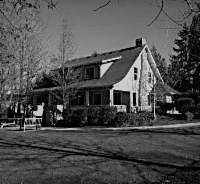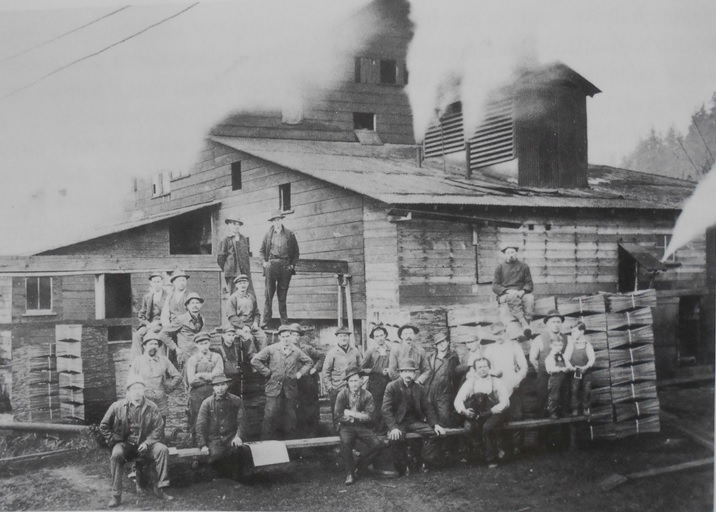No. 2 | February 20, 2019
Eastside Stories
Subscribe to Eastside Stories by emailing us at: info@eastsideheritagecenter.org
Eastside Stories is our way of sharing Eastside history through the many events, people places and interesting bits of information that we collect at the Eastside Heritage Center. We hope you enjoy these stories and share them with friends and family.
Welcome to Eastside Stories, a new series from the Eastside Heritage Center. Through these periodic postings we will bring Eastside History to life and highlight the people, places, and events that have shaped its remarkable evolution.
Logging the Eastside
When the first intrepid settlers made their way to the Eastside in the 1860s, mostly what they found were trees. Really big trees.
As with so many things in life, this presented both a problem and an opportunity. The problem was that most settlers wanted to do what most Americans did at that time: farm. The Homestead Act of 1862 made land pretty much free for the grabbing, and as the area around the town of Seattle got carved up, settlers headed across and around Lake Washington to stake their claims and start farming. But there were those trees—up to 150 feet tall and several feet across.
The opportunity was to turn those trees into dollars.
A crew from the Siler Logging Co. in Redmond cut a large cedar tree. The loggers on the upper left and right are standing on spring boards.
(OR/L 79.79.044)
The Puget Sound area had its start as timber country. The first commercial transaction in the new metropolis of Seattle (the Denny Party huddled in a cabin on Alki Point) consisted of the sale of a load of logs to a schooner captain for use as pilings in San Francisco Bay. The rapid growth of San Francisco after the Gold Rush provided a ready market for lumber, shingles, and pilings.
Getting those enormous logs to mills and ships presented a challenge. Water was the answer, and the timber cutters made their way along the many miles of shoreline on Puget Sound, gradually working their way inland. But since Lake Washington still lacked a good connection to Puget Sound, getting Eastside logs to mills was impossible at first. So the earliest Eastside settlers clearing their farms often had no choice but to burn the logs.
A locomotive belonging to the Hewitt and Lee logging company in Bellevue hauls a load of logs. (2002.147.004)
Three important changes, beginning in the 1880s, made Eastside logging profitable. First, mills began to spring up along Lake Washington, and then gradually inland. It would always make more sense to ship higher value lumber and shingles than to transport logs, so mills followed the loggers inland. A number of the largest mills were around Lake Sammamish, which was served by early rail lines.
Second, transportation improved. In 1885 a log sluice opened in Montlake, between Lake Washington and Portage Bay. This ditch had a gate at the upper end (Lake Washington was about nine feet higher than Portage Bay at that time) which was opened to let rushing water carry logs to the mills along Lake Union. Railroads began to extend across the Eastside in the 1880s, allowing easier shipping of logs and lumber.
Employees at Webber's Shingle Mill on Lake Sammamish. (OR/L 79.79.049)
Third, mechanization began to take over. Steam powered donkey engines pulled logs from hillsides and gullies using steel cables known as “wire rope.” Hand saws and axes were replaced with mechanized harvesting equipment. Trucks replaced horses and oxen.
By the 1920s, most of the Eastside had been logged off. Remaining smaller trees that were not worth cutting for timber, and are often seen standing alone in photos of the period, were taken for pulp. As timber was cut and stumps removed, farms spread across the Eastside. Aerial photos from the 1930s show few heavily wooded areas, with most of the Eastside taken up by farms and sparse second-growth forests.
Today, a sharp-eyed observer can see evidence of early logging. Western Red Cedar rots very slowly, and original stumps can be found in second growth forests around the Eastside. On the sides of many of these stumps, notches for springboards—platforms that allowed loggers to cut above the fat base of the tree--can still be seen.
Looking at the mature residential areas and dense second growth forests of the Eastside, it can be hard to imagine that 100 years ago most of the Eastside was quite barren. Fortunately those big trees have a way of growing back to provide us with beauty, shade and oxygen.
Our Mission To steward Eastside history by actively collecting, preserving, and interpreting documents and artifacts, and by promoting public involvement in and appreciation of this heritage through educational programming and community outreach.
Our Vision To be the leading organization that enhances community identity through the preservation and stewardship of the Eastside’s history.
Eastside Heritage Center is supported by 4 Culture











